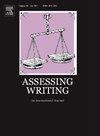用于评估基于源的写作质量的大规模语料库:ASAP 2.0
IF 5.5
1区 文学
Q1 EDUCATION & EDUCATIONAL RESEARCH
引用次数: 0
摘要
本文介绍了以美国中学生为对象的2.5万篇议论文为基础的数据集ASAP 2.0。该语料库通过包含人口统计数据、一致的评分标准和源文本解决了原始ASAP语料库的缺点。ASAP 2.0旨在支持公正、复杂的自动作文评分(AES)系统的发展,通过为学生提供总结,促进改进的教育实践。该语料库被设计为广泛的可访问性,希望促进对写作质量和AES系统偏差的研究。本文章由计算机程序翻译,如有差异,请以英文原文为准。
A large-scale corpus for assessing source-based writing quality: ASAP 2.0
This paper introduces ASAP 2.0, a dataset of ∼25,000 source-based argumentative essays from U.S. secondary students. The corpus addresses the shortcomings of the original ASAP corpus by including demographic data, consistent scoring rubrics, and source texts. ASAP 2.0 aims to support the development of unbiased, sophisticated Automatic Essay Scoring (AES) systems that can foster improved educational practices by providing summative to students. The corpus is designed for broad accessibility with the hope of facilitating research into writing quality and AES system biases.
求助全文
通过发布文献求助,成功后即可免费获取论文全文。
去求助
来源期刊

Assessing Writing
Multiple-
CiteScore
6.00
自引率
17.90%
发文量
67
期刊介绍:
Assessing Writing is a refereed international journal providing a forum for ideas, research and practice on the assessment of written language. Assessing Writing publishes articles, book reviews, conference reports, and academic exchanges concerning writing assessments of all kinds, including traditional (direct and standardised forms of) testing of writing, alternative performance assessments (such as portfolios), workplace sampling and classroom assessment. The journal focuses on all stages of the writing assessment process, including needs evaluation, assessment creation, implementation, and validation, and test development.
 求助内容:
求助内容: 应助结果提醒方式:
应助结果提醒方式:


